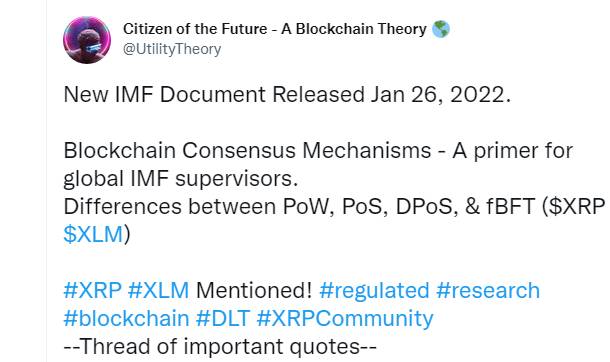
Stellar and Ripple appeared in the IMF document
XRP has always been a cryptocurrency that has caused much debate, discussion and even mystical interpretations. Regardless of how you feel about it, there has been a lot of information coming out lately that makes you feel like you are part of a conspiracy theory.
The World Bank recently published a report naming Ripple and Stellar as stablecoins, and now members of the XRP community have turned their attention to another document.
Most recently, on January 26, 2022, the International Monetary Fund (IMF) released a document, Blockchain Consensus Mechanisms, a primer for global supervisors. The gist of the document is that it describes the differences between PoW, PoS, DPoS and fBFT (Stellar and Ripple are given as examples), and provides guidance to supervisors.
The document was spotted by a Twitter user, and he went on to write the following important points about the document in his post.

Conclusions from the document that are noteworthy:
- Blockchain BTC. PoW is the most popular consensus mechanism, but it has significant drawbacks. A safe and resilient consensus generation method is PoW, but it consumes a significant amount of power and can be slow and expensive at times of high network traffic.
- Consensus mechanisms should not harm or interfere with the global goal of moving to a LOW-carbon economy. Energy-intensive methods pose an unacceptable risk to financial stability and societies.
- The IMF has stated that the financial sector plays an important role in combating climate change and seeks to support climate risk reduction and mitigation.
- The IMF states that PoW has the potential to lead to centralization. As mathematical puzzles become more complex, more computing power is required to solve them. Given the high costs, such technology is only available to certain individuals or entities or mining pools.
- IMF’s view of PoS: PoS is built as an outdated system for enriching the already wealthy.
- DPoS. The benefits of DPoS include energy savings, greater decentralization, and greater democratization. DPoS promotes greater democratization, decentralization, and can have positive results for regulated payment or trade finance activities.
- FBFT is Fast Byzantine Fault Tolerance, which aims to solve centralization problems with greater scalability. Well-known use cases: Ripple and Stellar. Has the following characteristics: Membership is open and control is decentralized and provides high efficiency for retail payments, wholesale settlements and other functions.
- The IMF considers PoW to be too energy intensive. PoW’s significant energy consumption, branching nature, and attendant probabilistic settlement issues can cause friction with many regulatory frameworks, regulatory mandates, and (BFA).
- Regulators should consider the consequences of different consensus mechanisms in terms of regulation, oversight, and consider an INDEPENDENT approach to TECHNOLOGY.